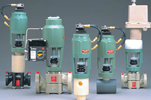

A unique range of all-plastic proportional control valves manufactured by Collins Instrument of the USA for process control applications is available from Randburg-based company C&F Technologies.
Collins manufactures a wide range of specialised control valves for corrosive chemical control applications and arduous corrosive environments. Suitable for applications in a number of industries including chemical, petrochemical, pulp and paper, and mineral beneficiation in the mining industry to name just a few, Collins control valves are extremely corrosion resistant, feature fast and accurate positioning and are available with a wide selection of valve-trim sizes.
Unique design
With actuators moulded of glass-filled, UV-inhibited polypropylene, and with the control valve bodies moulded from PVDF (Kynar) or polypropylene, or machined from solid PTFE or other more exotic materials, the Collins control valve makes for an extremely lightweight and durable proportional control valve that will give many years service with minimal maintenance requirements.
When the plastic actuator is assembled together with one of Collins plastic valve bodies, the combination represents an effective way to handle both the corrosive fluids that flow through the valve as well as the harsh atmospheric conditions that are often present and in which the valve is expected to function for long periods without any external corrosion taking place.
Valve sizes and characteristics
Available in sizes from 1/2 to 2" (1,3 cm to 5,1 cm), and having (Cv) flow coefficients from as low as 0,003 and up to 38, and with the choice of linear or percentage flow characteristics, the Collins valves are able to cater for a wide range of chemical applications that would otherwise have to use valves manufactured from exotic metals at higher price and longer deliveries.
Metal components used on the Collins valves are kept to an absolute minimum, being mainly limited to the aluminium valve positioner mounted on top of the actuator and the actuator hose end connectors. However, these metal components are very well protected against any corrosive environment by virtue of the actuator/positioner being immersed in a dip-seal solution that, when dry, leaves a thick plastic-like layer, over the complete actuator assembly.
Valve-stem sealing
Valve-stem seals are available in several materials and designs to ensure minimal fugitive emissions by maintaining the stem seals in constant compression by means of a live-load spring mechanism. For even more stringent sealing requirements, valves are available that utilise bellows seals in order to prevent any liquid or gas leakage under normal circumstances.
Ease of maintenance
Maintenance of the Collins valve is simplicity itself since the actuator can be separated from the valve body in seconds by withdrawal of a flexible polypropylene locking-ring which slots into the periphery of the actuator body and very effectively 'locks' the two parts together. Removing the locking-ring gives instant access to the actuator piston assembly without having to remove the valve positioner - meaning the piston seals can be changed in a matter of minutes in the event of failure without the need to re-stroke or calibrate the valve at all when re-assembled.
Similarly, the actuator can be quickly and easily removed from the valve body by simply disconnecting the valve stem from the piston rod and loosening the locking nut that holds the actuator to the valve body.
Because of the material of construction being plastics, and very light-weight, the Collins valves are very easy to remove from the pipeline when needed, thus offering minimal process downtime.
Cost comparisons
Although not cost-effective for general-purpose process control applications, the Collins valve comes into its own when its cost and longer life expectancy is compared against more expensive control valves using exotic materials of construction such as hastalloy, tantalum, monel or carpenter 20, for the valve body and trim. In such cases the total cost of ownership, light weight, and ease of maintenance make them ideally suitable for the more aggressive chemical environments where external corrosion is a limiting factor in the use of metal actuators.
For more information contact J Gill, C&F Technologies, +27 (0)11 792 4588.
| Tel: | +27 11 792 4588 |
| Email: | [email protected] |
| www: | www.flowmeters.co.za |
| Articles: | More information and articles about C&F Technologies |

© Technews Publishing (Pty) Ltd | All Rights Reserved